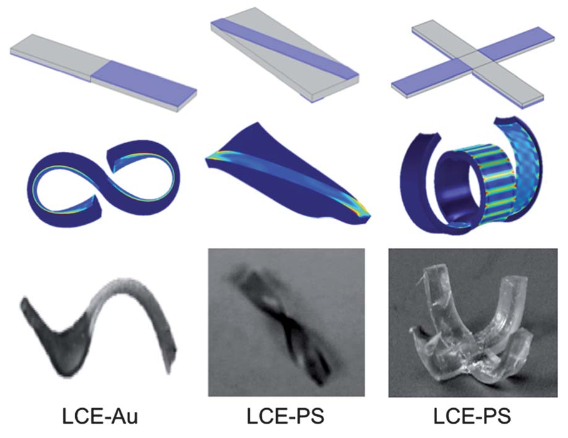A biocompatible shape-changing material controlled by patterns and heat
Can be used as cell-culture substrates or implantable materials that contract and expand
December 12, 2013
[+]
The materials created by Rice University polymer scientist Rafael Verduzco
and his colleagues start as flat slabs, but morph magically into shapes
that can be controlled by patterns that were formed into their layers.
A
two-layer material designed to morph into a specific shape when heated
to a specific temperature range. The morphing material may be useful for
bioengineering, optical, pharmaceutical, and other applications.
(Credit: Aditya Agrawal et al./Soft Matter (adapted))
Materials that can change their shape based on environmental conditions are useful for optics, three-dimensional biological scaffolds, and controlled encapsulation and release of drugs, among other applications, according to the researchers.
“We already know the materials are biocompatible, stable and inert,” Verduzco said, “so they have great potential for biological applications.”
‘Programming’ shape-shifters
The material needs two layers to perform its magic:
- A liquid crystal elastomer (LCE), a rubber-like material of cross-linked polymers that line up along a single axis, called the “nematic director.”
- A thin layer of simple polystyrene, placed either above or below the LCE.
The lab discovered that the layers would react to heat in a predictable and repeatable way, allowing for configurations to be designed into the material depending on a number of parameters: the shape and aspect ratio of the LCE, the thickness and patterning of the polystyrene, and even the temperature at which the polystyrene was applied.
Complex shapes based on patterns in materials
[+]
The lab made spiraling, curling and X-shaped materials that
alternately closed in or stood up on four legs. Placing polystyrene on
top of one half of a strip of LCE and on the bottom of the other half
produced an “S” shape. Verduzco suggested there’s no limit to the
complexity of the shapes that could be teased from the material with
proper patterning.
Shape
;changes. (Top) Schematics showing initially flat liquid crystal
elastomer (LCE) samples with polystyrene (PS) or gold (Au) film
deposited on a portion of the LCE. Shaded (purple) regions indicate
where PS or Au is deposited. (Middle) Simulation predictions of the
resulting shape-change for patterned LCE bilayers. (Bottom) Experimental
examples showing actual shape changes. (Credit: Aditya Agrawal et al./Soft Matter)
The primary direction of folding or wrinkling of the material was set by the temperature at which the polystyrene layer was deposited. In experiments, the researchers found that when the polystyrene layer was applied at 5–6 degrees Celsius (about 42 degrees Fahrenheit), the material would wrinkle perpendicular to the LCE’s nematic director.
At 50 C (122 degrees F), the polystyrene wrinkled parallel to the director. The micrometer-scale wrinkles seemed smooth to the naked eye.
As expected, however, if the polystyrene layer was too thick, it would not allow the composite material to bend. And if the temperature got too hot, the polystyrene would pass its glass transition temperature and allow the composite to relax back into its flat shape.
When the material cooled to room temperature and the polystyrene became glassy again, it would deform in the opposite direction, but it could return to its initial flat-at-room-temperature state if annealed with a solvent, dicloromethane, that relaxed the layers once more.
Substrates for cell cultures or implantable materials
“For any application, you would want to be able to change shape and then go back,” Verduzco said. “LCEs are reversible, unlike shape-memory polymers that change shape only once and cannot go back to their initial shape. This is important for biomedical applications, such as dynamic substrates for cell cultures or implantable materials that contract and expand in response to stimulus. This is what we are targeting with these applications.”
Lead author Aditya Agrawal and co-author Stacy Pesek are graduate students and Tae Hyun Yun is an undergraduate at Rice. Co-author Walter Chapman is the William W. Akers Professor of Chemical and Biomolecular Engineering at Rice. Verduzco is an assistant professor of chemical and biomolecular engineering.
The John S. Dunn Foundation Collaborative Research Award Program administered by the Gulf Coast Consortia and the American Chemical Society Petroleum Research Fund supported the research.
Abstract of Soft Matter paper
Monodomain liquid crystal elastomers (LCEs) are shape-responsive materials, but shape changes are typically limited to simple uniaxial extensions or contractions. Here, we demonstrate that complex surface patterns and shape changes, including patterned wrinkles, helical twisting, and reversible folding, can be achieved in LCE–polystyrene (PS) bilayers. LCE–PS bilayer shape changes are achieved in response to simple temperature changes and can be controlled through various material parameters including overall aspect ratio and LCE and polystyrene film thicknesses. Deposition of a patterned PS film on top of an LCE enables the preparation of an elastomer that reversibly twists and a folding leaf-like elastomer, which opens and closes in response to temperature changes. The phenomena are captured through finite element simulations, in quantitative agreement with experiments.
(¯`*• Global Source and/or more resources at http://goo.gl/zvSV7 │ www.Future-Observatory.blogspot.com and on LinkeIn Group's "Becoming Aware of the Futures" at http://goo.gl/8qKBbK │ @SciCzar │ Point of Contact: www.linkedin.com/in/AndresAgostini
 Washington
Washington